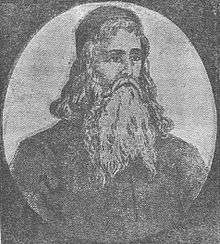Maharsha
Shmuel Eidels (1555 – 1631) (Hebrew: שמואל אליעזר הלוי איידלס Shmuel Eliezer HaLevi Eidels), was a renowned rabbi and Talmudist famous for his commentary on the Talmud, Chiddushei Halachot. Eidels is also known as Maharsha (מהרש"א,[1] a Hebrew acronym for "Our Teacher, the Rabbi Shmuel Eidels").
Shmuel Eidels | |
|---|---|
 Maharsha | |
| Personal | |
| Born | 1555 |
| Died | 1631 (aged 75–76) |
| Religion | Judaism |
Biography
The Maharsha was born in Kraków in Poland. His father, Yehuda,[2][3] was a Talmudist and both parents were descendants of rabbinic families—his mother Gitel was a cousin of Rabbi Yehuda Loew, the Maharal of Prague, and his father "was a direct descendant of Rabbi Yehuda HaChasid."[4] From early childhood, the Maharsha's remarkable talents were evident. When he came of marriageable age, the Maharsha was offered many prestigious shidduchim (marriage partners), but he rejected them, asserting that he wanted to devote himself solely to Torah study.
He married the daughter of Edel Lifschitz of Posen and the late Moshe Lifschitz, rabbi of Brisk. He then moved to Posen and, with his mother-in-law's financial help, established a yeshiva there.[3] She supported it for over 2 decades,[5] including "taking care of every bachur's needs."
In appreciation of her support he adopted her name. After her death, he served as rabbi in the following prominent communities: Chelm (1610),[2] Lublin, Tiktin[6] and Ostroh. Eidels was also active in the Council of Four Lands.
His son-in-law was R. Moses ben Isaac Bonems of Lublin, who authored his own novellæ on the Talmud, published with the Ḥiddushe Halakhot, last recension (Mahdura Batra).[3]
The Maharsha passed away "5 days in(to) the month of Kislev, year"[7] 5392.[8]
Works
Chiddushei Halachot (חידושי הלכות - "Novellae in Jewish Law") is an "incisive and keenly analytical" commentary on the Talmud, Rashi and Tosafot together, and with a focus on Tosafot. It is said that if one grasps the Maharsha, then one has understood the Tosafot.[9] This commentary was quickly accepted and was printed in almost all editions of the Talmud. Chiddushei Halachot is based on Maharsha's teaching in his yeshiva, and he refrained from printing his commentary on those pages that were studied while he served on the Council of Four Lands.
The Maharsha also wrote an extensive commentary on the aggadot of the Talmud known as the Chiddushei Aggadot (חידושי אגדות - "Novellae in Aggadah") reflecting a wide knowledge of philosophy and Kabbalah. Maharsha on Aggados is a multi-volume translation by Rabbi Avraham Yaakov Finkel.[10]
Great Maharsha Synagogue

The Great Maharsha Synagogue is located in Ostroh (Ukraine). It was built in 1627 under a restriction "prohibiting the erection of synagogues taller than churches."[11] The synagogue was damaged during the Khmelnytsky massacres and centuries later, once again, during the Holocaust.[11]
References
- MaHarSha, accent on "SHA" "Rabbi Shmuel Eliezer Edels (MaHarSha) 1555–1631". ou.org. April 15, 2014.
- Nissan Mindel. "Rabbi Shmuel Eliezer Edeles". chabad.org.
- "5 Kislev Yartzeits". TorahTots.com.
- "Tziyon Of Kever Of The Maharsha In Ukraine Found Desecrated". Yeshivaworld. April 29, 2018.
- 24 according to cited source
- "The Great Maharsha". National Jewish Outreach Program. November 12, 2010.
After .. served as the rabbi of Chelm, Lublin, Ticktin (sic) and Ostrog.
- opening words of his monument's text
- "5th of Kislev – Yahrzeit of the MaHaRSHA". BreslovTorah.com.
on the 5th of Kislev 5392 (1631).
- "Rabbi Shmuel Eliezer Edels (MaHarSha)". JewishVirtualLibrary.org.
- "Maharsha On Aggados Volume 2: Avraham Finkel". 2007. ISBN 1-892692-22-8.
- Sergey R. Kravtsov (December 17, 2015). "The Great Maharsha Synagogue in Ostroh: Memory and Oblivion. Have we reached the point of no return?". Retrieved September 12, 2019.
External links
| Wikimedia Commons has media related to Samuel Eidels. |
- Short biography of Rabbi Shmuel Eliezer Edeles (MaHaRSHA), chabad.org
- Rabbi Shmuel Eliezer Edels (MaHarSha), ou.org
- Samuel Eliezer Eidels, jewishhistory.org.il
- Family Tree